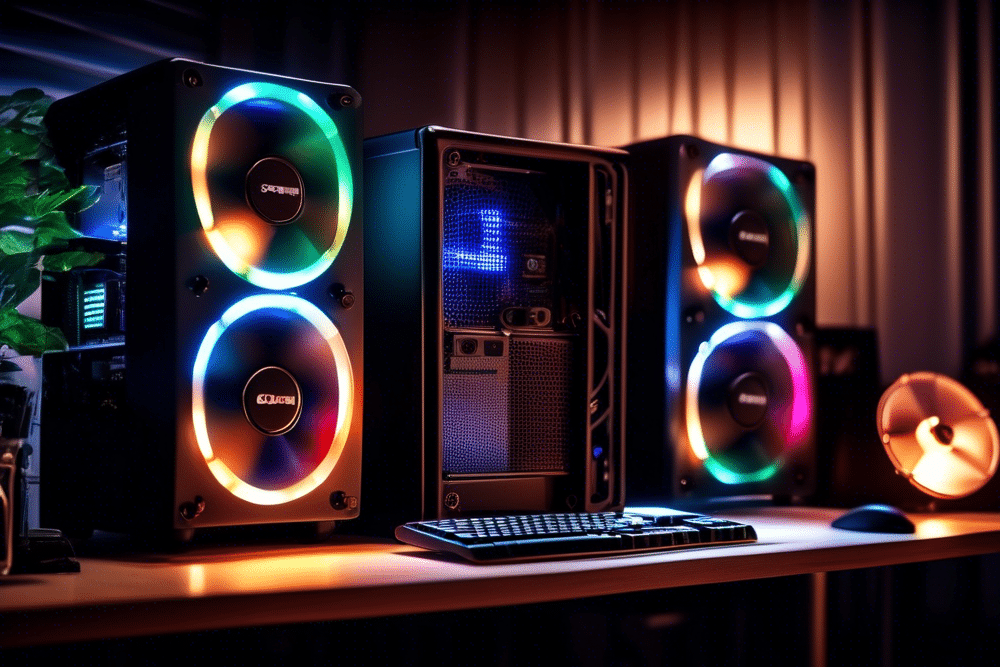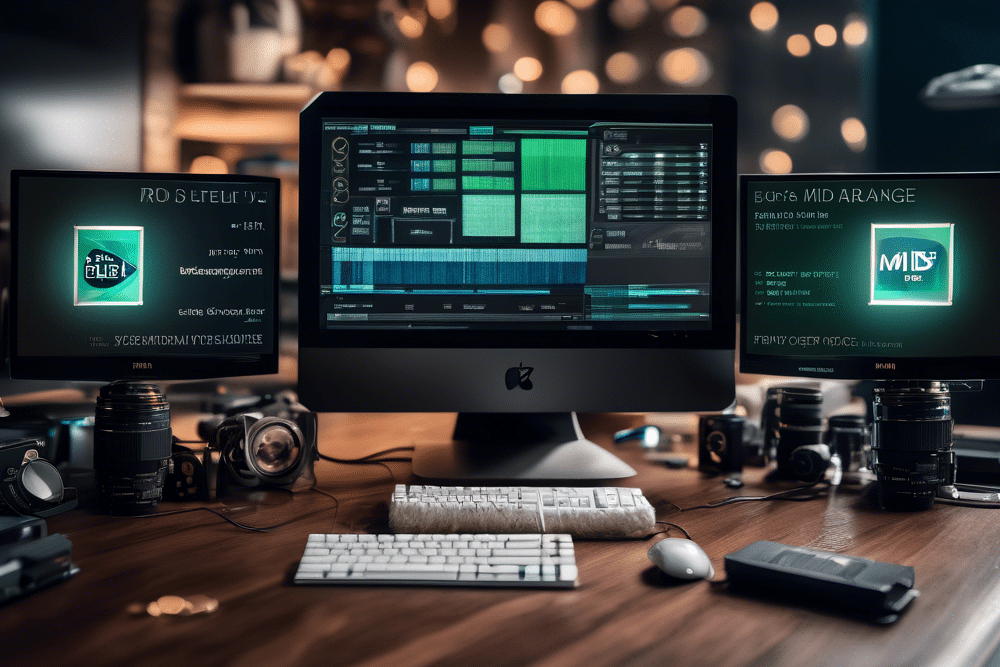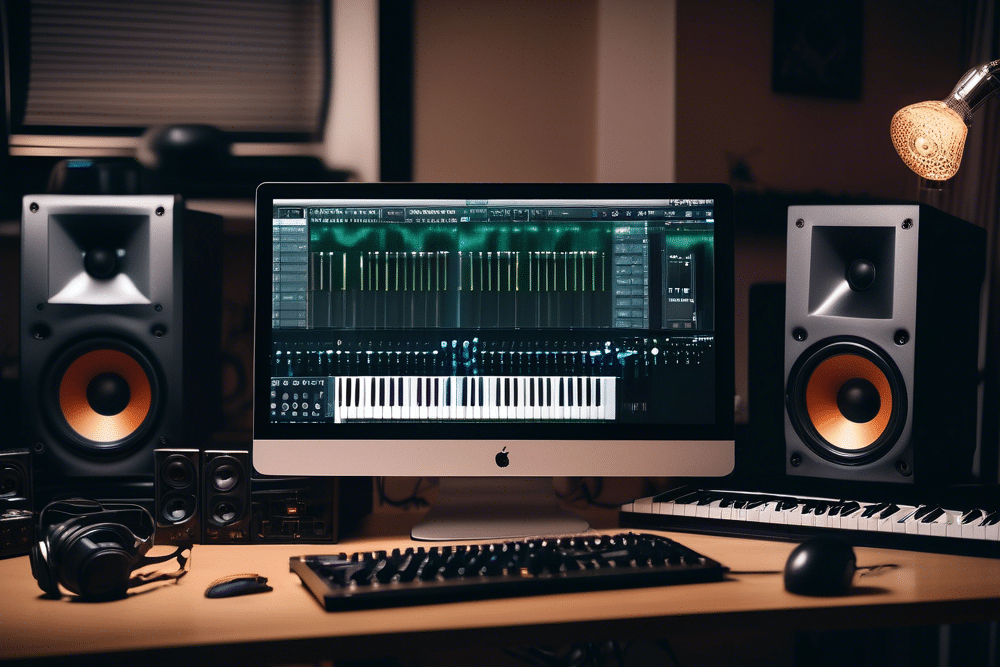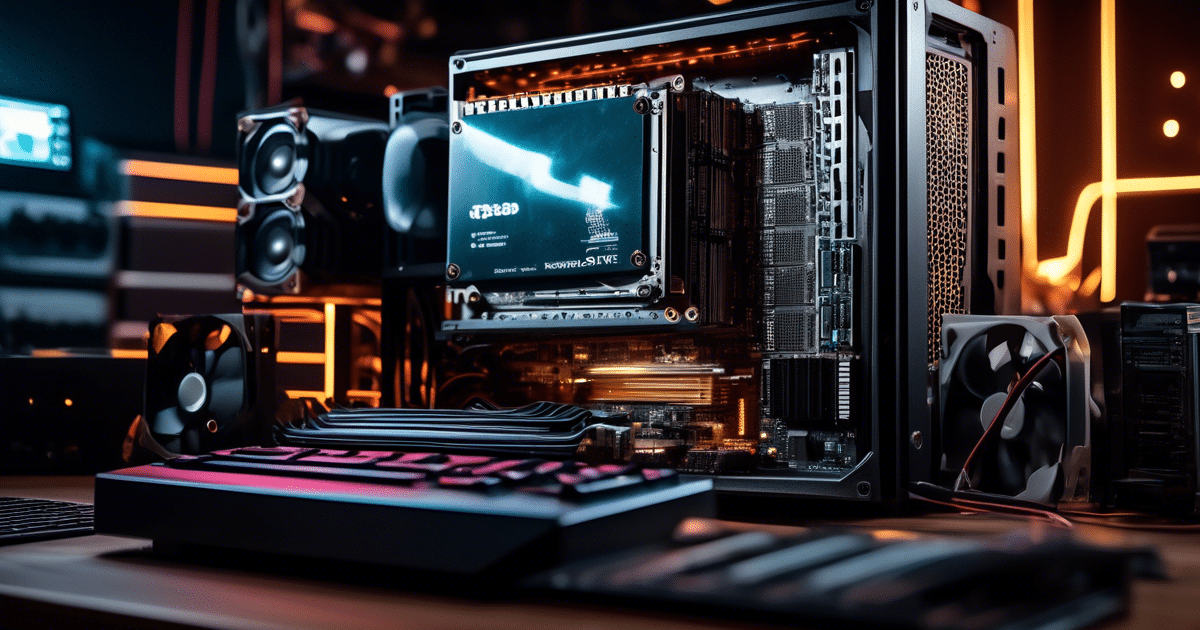Estimated reading time: 10 minutes
As a music producer, your desktop computer is more than just a machine—it’s the core of your creative process. It’s where your ideas come to life, where melodies are born, and where tracks are polished to perfection. But with so many options out there, how do you choose the best desktop for music production? Whether you’re a seasoned pro or just starting out, this comprehensive guide will help you navigate the world of music production desktops and find the perfect setup for your needs.
Table of contents
- The Foundation: Understanding Your Needs
- The Brain of the Operation: Best CPU for Music Production
- Memory Matters: RAM for Audio Workstation
- Storage Solutions: SSD Storage for Music
- Putting It All Together: Music Production Computer Specs
- Beyond the Specs: Other Considerations
- DAW Hardware Requirements: Matching Your Software Needs
- Music Production Desktop Comparison: Popular Pre-Built Options
- Best Computer for Recording Music: Studio Considerations
- Professional Audio Workstation Setup: Beyond the Desktop
- Video: What’s The BEST Computer For Music Production?
- Conclusion: Crafting Your Perfect Music Production Desktop
- FAQs
The Foundation: Understanding Your Needs
Before we dive into the nitty-gritty of computer specs, let’s take a moment to consider what you really need from your music production desktop. Every producer has unique requirements, influenced by factors such as:
- The complexity of your projects
- The number of tracks you typically work with
- The types of virtual instruments and plugins you use
- Your budget constraints
By understanding these factors, you’ll be better equipped to make an informed decision about your music production desktop. Remember, the goal is to find a system that not only meets your current needs but also has room to grow as your skills and projects evolve.
The Brain of the Operation: Best CPU for Music Production
Why CPU Matters in Music Production
The Central Processing Unit (CPU) is arguably the most critical component of your music production desktop. It’s responsible for handling all the complex calculations required to process audio, run virtual instruments, and manage your Digital Audio Workstation (DAW). This processing power is particularly vital when you’re learning how to make Hardstyle music, a genre known for its complex layers and heavy effects. A powerful CPU can mean the difference between smooth, lag-free production and frustrating stutters and crashes.
Top CPU Choices for Music Producers
When it comes to choosing the best CPU for music production, you’ll typically be looking at options from Intel or AMD. Here are some top contenders:
- Intel Core i7 or i9 (10th gen or newer)
- AMD Ryzen 7 or 9 (3000 series or newer)
These processors offer excellent multi-core performance, which is crucial for handling multiple tracks and plugins simultaneously. The exact model you choose will depend on your budget and specific needs, but aim for at least 6 cores and a clock speed of 3.5GHz or higher.
Balancing Performance and Budget
While it’s tempting to go for the most powerful CPU available, it’s important to balance performance with your budget. Remember, other components like RAM and storage are also crucial for a well-rounded music production desktop. A mid-range CPU paired with ample RAM and fast storage can often outperform a top-tier CPU with subpar supporting components.
Memory Matters: RAM for Audio Workstation
The Role of RAM in Music Production
Random Access Memory (RAM) is where your computer stores data for quick access. In music production, this means your virtual instruments, audio samples, and project files. For example, a vast library of professional Hardstyle Samples and sound kits will take up considerable space, making a large and fast drive essential. The more RAM you have, the more complex your projects can be without bogging down your system. Understanding the fundamentals of what Hardstyle music is helps to appreciate its intricate structures, which can be very demanding on your system’s memory.
How Much RAM Do You Need?
For modern music production, consider 16GB as the bare minimum. However, if you work with large sample libraries or complex multi-track projects, 32GB or even 64GB can provide a noticeable performance boost. Here’s a general guideline:
- 16GB: Suitable for beginners or those working on simpler projects
- 32GB: A sweet spot for most producers, handling most projects comfortably
- 64GB or more: Ideal for professional producers working on complex arrangements with numerous virtual instruments and effects
Quality Matters Too
When choosing RAM for your music production desktop, don’t just focus on quantity. Look for high-quality RAM from reputable manufacturers. Faster RAM (higher MHz) can also provide a performance boost, especially when paired with a capable CPU.
Storage Solutions: SSD Storage for Music
The SSD Revolution in Music Production
Solid State Drives (SSDs) have revolutionized music production workflows. The rapid loading times of an SSD are a significant advantage when producing some of the fastest types of Techno, where maintaining a creative flow is crucial. Unlike traditional Hard Disk Drives (HDDs), SSDs have no moving parts, allowing for much faster read and write speeds. This translates to quicker project load times, faster plugin loading, and smoother playback of large sample libraries.
Choosing the Right SSD
When selecting an SSD for your music production desktop, consider the following:
- Capacity: Aim for at least 500GB for your system drive, with additional storage for your sample libraries and project files
- Type: NVMe SSDs offer the fastest speeds but are more expensive. SATA SSDs are still a significant upgrade from HDDs and are more budget-friendly
- Reliability: Look for SSDs with good endurance ratings, as music production involves frequent read and write operations
Storage Configuration Tips
For optimal performance, consider a multi-drive setup:
- A fast NVMe SSD for your operating system and DAW
- A separate SSD for your sample libraries and virtual instruments
- A large HDD for archiving completed projects and less frequently used files
This configuration ensures fast system performance while providing ample storage for your growing music library.
If your productions lean towards the more extreme end of the spectrum, our Hardcore Essentials sample pack offers the perfect sounds to push your new machine to its limits.
Putting It All Together: Music Production Computer Specs
Now that we’ve covered the core components, let’s look at some sample configurations for music production desktops:
Entry-Level Setup
- CPU: AMD Ryzen 5 3600 or Intel Core i5-10600K
- RAM: 16GB DDR4
- Storage: 500GB NVMe SSD + 1TB HDD
- Graphics: Integrated graphics (dedicated GPU not necessary for most music production tasks)
This setup is suitable for beginners or those working on simpler projects. It provides a solid foundation that can be upgraded as your needs grow.
Mid-Range Powerhouse
- CPU: AMD Ryzen 7 5800X or Intel Core i7-11700K
- RAM: 32GB DDR4
- Storage: 1TB NVMe SSD + 2TB SATA SSD
- Graphics: Basic dedicated GPU (e.g., NVIDIA GTX 1650) for multi-monitor support
This configuration offers excellent performance for most music producers, handling complex projects with ease.
Professional-Grade Workhorse
- CPU: AMD Ryzen 9 5950X or Intel Core i9-11900K
- RAM: 64GB DDR4
- Storage: 2TB NVMe SSD + 4TB SATA SSD + 4TB HDD
- Graphics: Mid-range GPU (e.g., NVIDIA RTX 3060) for smooth multi-monitor performance and potential video editing tasks
This high-end setup is designed for professional producers working on demanding projects with numerous tracks, virtual instruments, and effects.
Beyond the Specs: Other Considerations
Noise Levels: Keeping It Quiet
When choosing a desktop for music production, don’t forget about noise levels. The last thing you want is a noisy computer fan disrupting your recording sessions. Look for cases with good airflow and consider quiet cooling solutions like liquid cooling for your CPU.

Expandability: Room to Grow
Choose a desktop with room for future upgrades. A case with extra drive bays and a motherboard with additional RAM slots and PCIe lanes can extend the life of your system as your needs evolve.
Connectivity: Staying in Sync
Ensure your chosen desktop has the ports you need for your audio interface, MIDI controllers, and other peripherals. USB 3.0 ports, Thunderbolt connections, and multiple audio outputs can all be valuable for a music production setup.
DAW Hardware Requirements: Matching Your Software Needs
Different Digital Audio Workstations (DAWs) may have varying hardware requirements. Whether you’re trying to emulate the sound of famous Hardstyle artists or just exploring the relationship between Hardstyle and the broader world of electronic music, ensuring your DAW and hardware are aligned is a critical first step. While most modern music production desktops will handle popular DAWs without issue, it’s worth checking the system requirements for your preferred software. Some DAWs, like Pro Tools, may have specific hardware recommendations or requirements.
Common DAW Hardware Requirements
While requirements can vary, here are some general guidelines that will cover most DAWs:
- CPU: Multi-core processor (4+ cores) with high single-thread performance
- RAM: 8GB minimum, 16GB or more recommended
- Storage: SSD for system and project files
- Graphics: Integrated graphics sufficient for most DAWs, dedicated GPU may be beneficial for video-heavy work
Always check the specific requirements for your chosen DAW to ensure compatibility.
Music Production Desktop Comparison: Popular Pre-Built Options
While building a custom desktop allows for maximum flexibility, many producers opt for pre-built systems. Here’s a quick comparison of some popular options:

Apple Mac Pro
- Pros: Powerful performance, optimized for creative work, excellent build quality
- Cons: Expensive, limited upgradeability, not all music software available for macOS
Dell XPS Tower
- Pros: Good balance of performance and price, easily upgradeable
- Cons: May require some tweaking for optimal music production performance
HP OMEN
- Pros: High-performance options available, good cooling system
- Cons: Some models may include unnecessary gaming features
Custom-built by music-focused companies
- Pros: Optimized for audio work, often come with DAW and plugins pre-installed
- Cons: Can be more expensive than building yourself or buying a general-purpose desktop
Best Computer for Recording Music: Studio Considerations
When setting up a recording studio, your desktop choice becomes even more critical. Here are some additional factors to consider:
Electromagnetic Interference (EMI)
Some desktop components can produce EMI, which may introduce unwanted noise in your recordings. Look for well-shielded components and consider placing your desktop away from sensitive audio equipment.
Multiple Monitor Support
Recording often benefits from a multi-monitor setup. Ensure your chosen desktop (and its graphics capabilities) can support the number and resolution of monitors you plan to use.
Reliability and Support
For a professional recording setup, consider the reliability of components and the quality of customer support. Business-class desktops or workstations might offer better long-term reliability and support options.
Professional Audio Workstation Setup: Beyond the Desktop

Remember, your desktop is just one part of a professional audio workstation setup. Other crucial components include:
- High-quality audio interface
- Studio monitors
- MIDI controllers
- Acoustic treatment for your space
Ensure your budget accounts for these elements alongside your desktop investment.
Video: What’s The BEST Computer For Music Production?
Conclusion: Crafting Your Perfect Music Production Desktop
Choosing the best desktop for music production is a personal journey. It’s about finding the right balance of performance, reliability, and budget that aligns with your creative needs. Whether you opt for a pre-built system or embark on a custom build, the key is to create a setup that empowers your creativity rather than hindering it.
Remember, the “best” desktop is the one that lets you focus on what really matters—making great music. So take your time, do your research, and don’t be afraid to ask for advice from fellow producers. With the right tools at your fingertips, there’s no limit to what you can create.
Now, armed with this knowledge, you’re ready to make an informed decision about your music production desktop. Happy producing, and may your new setup inspire countless hours of musical creativity!
Related Posts
FAQs
A multi-core CPU handles parallel audio processing—more cores let you run more tracks, virtual instruments, and plugins without stutters.
16 GB is the minimum; 32 GB is ideal for most producers; 64 GB or more is recommended if you use huge sample libraries or very large projects.
Use a fast NVMe SSD for your OS, DAW, and active projects; reserve larger HDDs for archive storage and backups.
Not strictly—integrated graphics can suffice. A basic dedicated GPU is only needed if you run multiple high-res displays or do video/audio work.
Choose a case with good airflow, use quiet fans or liquid cooling, and place the desktop away from your microphone to minimize noise pickup.
